Forest Carbon Storage and Carbon Sequestration Potential in Shaanxi Province, China
Abstract
:1. Introduction
2. Material and Methods
2.1. Study Area
2.2. Data Sources
2.2.1. Forest Resource Inventory Database
2.2.2. Carbon Measurement Parameters
2.3. Estimation of Carbon Storage
2.3.1. The Carbon Storage of Arbor Forest
2.3.2. The Carbon Storage of Sparse Woodland, Scattered Woodland, Economic Tree Species, and Four-Side Trees
2.3.3. Biomass of Bamboo Forest
2.3.4. Biomass of Shrubland
2.4. Estimation of Carbon Sequestration Potential
2.4.1. Scenario Assumptions
2.4.2. Fitting of Unit Area Stock–Age Equation in Arbor Forests
2.4.3. Prediction of Future Expanded Forest Area
2.4.4. Calculation of Carbon Sequestration Potential
2.5. Data Statistical Analysis
3. Results
3.1. Forest Carbon Storage and Carbon Sequestration Capacity
3.2. Carbon Storage and Carbon Density of Different Age Groups in Different Forest Types
3.3. Carbon Storage and Carbon Density of Dominant Tree Species (Groups) of Different Origins
3.4. The Carbon Sequestration Potential of Arbor Forests
4. Discussion
4.1. The Influence of Forest Type and Age on Forest Vegetation Carbon Density
4.2. Strategies and Suggestions to Increase Carbon Storage in Forests
4.3. Uncertainties
5. Conclusions
Author Contributions
Funding
Data Availability Statement
Acknowledgments
Conflicts of Interest
Appendix A
| Planted Forests | a | b | c | R2 | Natural Forests | a | b | c | R2 |
|---|---|---|---|---|---|---|---|---|---|
| Other hard broad leaf | 50.988 | 28.626 | 0.171 | 0.88 | Mixed coniferous and broad leaf | 123.744 | 6.994 | 0.039 | 0.967 |
| Pinus tabulaeformis | 271.498 | 53.557 | 0.096 | 0.99 | Mixed broad leaf | 102.556 | 2.675 | 0.065 | 0.888 |
| Other soft broad leaf | 71.536 | 38.382 | 0.212 | 0.994 | Quercus spp. | 98.185 | 15.797 | 0.079 | 0.995 |
| Pinus massoniana | 116.291 | 13.831 | 0.137 | 0.993 | Other hard broad leaf | 110.305 | 11.164 | 0.058 | 0.992 |
| Poplar and Willow | 218.082 | 4.334 | 0.071 | 0.988 | Pinus tabulaeformis | 165.042 | 26.176 | 0.064 | 0.986 |
| Pinus levis | 484.395 | 15.503 | 0.026 | 0.955 | Other soft broad leaf | 106.504 | 20.268 | 0.201 | 0.994 |
| Cunninghamia lanceolata | 130.94 | 12.036 | 0.193 | 0.988 | Betula spp. | 141.63 | 8.003 | 0.044 | 0.946 |
| Larix spp. | 112 | 39.972 | 0.172 | 0.998 | Pinus massoniana | 185.056 | 6.956 | 0.046 | 0.998 |
| Cupressus funebris | 51.876 | 24.961 | 0.077 | 0.971 | Poplar and Willow | 84.754 | 17.416 | 0.186 | 0.966 |
| Quercus spp. | 236.331 | 9.569 | 0.037 | 0.996 | Cupressus funebris | 146.136 | 4.095 | 0.011 | 0.965 |
| Mixed broad leaf | 120.323 | 1.947 | 0.04 | 0.675 | Pinus levis | 100.8 | 22.195 | 0.105 | 0.899 |
| Robinia pseudoacacia | 133.516 | 1.317 | 0.016 | 0.702 | Abies spp. | 292.762 | 7.153 | 0.036 | 0.974 |
| Mixed coniferous and broad leaf | 146.221 | 1.947 | 0.04 | 0.675 | Mixed coniferous | 152.009 | 14.306 | 0.078 | 0.99 |
| Castanea mollissima | 133.516 | 1.317 | 0.016 | 0.702 | Cunninghamia lanceolata | 124.719 | 11.4 | 0.195 | 0.968 |
| Mixed coniferous | 105.319 | 1.888 | 0.035 | 0.488 | Ulmus pumila | 73.753 | 19.587 | 0.086 | 0.831 |
| Picea spp. | 331.677 | 1.395 | 0.01 | 0.621 | Tilia tuan | 126.084 | 1.452 | 0.038 | 0.913 |
| Ulmus pumila | 133.516 | 1.317 | 0.016 | 0.702 | Tsuga chinensis | 292.762 | 7.153 | 0.036 | 0.974 |
| Abies spp. | 452.851 | 12.192 | 0.04 | 0.997 | Other pine species | 185.056 | 6.956 | 0.046 | 0.998 |
| Pinus sylvestris var. mongholica | 176.918 | 16.783 | 0.099 | 0.992 |
References
- IPCC. Climate Change 2022: Impacts, Adaptation, and Vulnerability[M/OL]; Cambridge University Press: Cambridge, UK, 2022; pp. 3–31. [Google Scholar]
- Forzieri, G.; Dakos, V.; McDowell, N.G.; Ramdane, A.; Cescatti, A. Emerging signals of declining forest resilience under climate change. Nature 2022, 608, 534–539. [Google Scholar] [CrossRef] [PubMed]
- Ke, S.; Zhang, Z.; Wang, Y. China’s forest carbon sinks and mitigation potential from carbon sequestration trading perspective. Ecol. Indic. 2023, 148, 110054. [Google Scholar] [CrossRef]
- Yu, M.; Song, Y.I.; Ku, H.; Hong, M.; Lee, W.K. National-scale temporal estimation of South Korean Forest carbon stocks using a machine learning-based meta model. Environ. Impact Assess. Rev. 2023, 98, 106924. [Google Scholar] [CrossRef]
- Matuszkiewicz, J.M.; Affek, A.N.; Kowalska, A. Current and potential carbon stock in the forest communities of the Białowieża Biosphere Reserve. For. Ecol. Manag. 2021, 502, 119702. [Google Scholar] [CrossRef]
- Fu, Y.J.; Tian, D.; Hou, Z.Y.; Wang, M.G.; Zhang, N.L. Review on evaluating global forest carbon sink. J. Beijing For. Univ. 2022, 44, 1–10. [Google Scholar] [CrossRef]
- Case, M.J.; Johnson, B.G.; Bartowitz, K.J.; Hudiburg, T.W. Forests of the future: Climate change impacts and implications for carbon storage in the Pacific Northwest, USA. For. Ecol. Manag. 2021, 482, 118886. [Google Scholar] [CrossRef]
- Sha, Z.; Bai, Y.; Li, R.; Lan, H.; Zhang, X.; Li, J.; Xie, Y. The global carbon sink potential of terrestrial vegetation can be increased substantially by optimal land management. Commun. Earth Environ. 2022, 3, 8. [Google Scholar] [CrossRef]
- Pan, Y.; Birdsey, R.A.; Fang, J.; Houghton, R.; Kauppi, P.E.; Kurz, W.A.; Hayes, D. A large and persistent carbon sink in the world’s forests. Science 2011, 333, 988–993. [Google Scholar] [CrossRef]
- Pugh, T.A.; Lindeskog, M.; Smith, B.; Poulter, B.; Arneth, A.; Haverd, V.; Calle, L. Role of forest regrowth in global carbon sink dynamics. Proc. Natl. Acad. Sci. USA 2019, 116, 4382–4387. [Google Scholar] [CrossRef]
- Griscom, B.W.; Adams, J.; Ellis, P.W.; Fargion, J. Natural climate solutions. Proc. Natl. Acad. Sci. USA 2017, 114, 11645–11650. [Google Scholar] [CrossRef]
- Brienen, R.J.; Caldwell, L.; Duchesne, L.; Voelker, S.; Barichivich, J.; Baliva, M.; Gloor, E. Forest carbon sink neutralized by pervasive growth-lifespan trade-offs. Nat. Commun. 2020, 11, 4241. [Google Scholar] [CrossRef] [PubMed]
- Fang, J.; Chen, A.; Peng, C.; Zhao, S.; Ci, L. Changes in forest biomass carbon storage in China between 1949 and 1998. Science 2001, 292, 2320–2322. [Google Scholar] [CrossRef] [PubMed]
- Li, Q.; Zhu, J.H.; Feng, Y.; Xiao, W.F. Carbon storage and carbon sequestration potential of the forest in China. Clim. Chang. Res. 2018, 14, 287–294. [Google Scholar] [CrossRef]
- Ameray, A.; Bergeron, Y.; Valeria, O. Forest carbon management: A review of silvicultural practices and management strategies across boreal, temperate and tropical forests. Curr. For. Rep. 2021, 7, 245–266. [Google Scholar] [CrossRef]
- Cai, W.; He, N.; Li, M.; Xu, L.; Wang, L.; Zhu, J.; Sun, O.J. Carbon sequestration of Chinese forests from 2010 to 2060: Spatiotemporal dynamics and its regulatory strategies. Sci. Bull. 2022, 67, 836–843. [Google Scholar] [CrossRef]
- Chen, S.; Lu, N.; Fu, B.; Wang, S.; Deng, L.; Wang, L. Current and future carbon stocks of natural forests in China. For. Ecol. Manag. 2022, 511, 120137. [Google Scholar] [CrossRef]
- Chen, L.C.; Guan, X.; Li, H.M.; Wang, Q.K.; Zhang, W.D.; Yang, Q.P.; Wang, S.L. Spatiotemporal patterns of carbon storage in forest ecosystems in Hunan Province, China. For. Ecol. Manag. 2019, 432, 656–666. [Google Scholar] [CrossRef]
- Ren, Y.; Wei, X.; Zhang, L.; Cui, S.; Chen, F.; Xiong, Y.; Xie, P. Potential for forest vegetation carbon storage in Fujian Province, China, determined from forest inventories. Plant Soil 2011, 345, 125–140. [Google Scholar] [CrossRef]
- Wang, Y.; Liu, L.; Shangguan, Z. Dynamics of forest biomass carbon stocks from 1949 to 2008 in Henan Province, east-central China. J. For. Res. 2018, 29, 439–448. [Google Scholar] [CrossRef]
- Ma, Q.; Liu, K.; Zhang, H. Carbon Storage by Forest Vegetation and Its Spatial Distribution in Shaanxi. Resour. Sci. 2012, 34, 1781–1789. (In Chinese) [Google Scholar]
- Cao, Y.; Chen, Y.M.; Jin, B.; Qu, M. Carbon storage and density of forest vegetation and its spatial distribution pattern in Shaanxi Province. J. Arid Land Resour. Environ. 2014, 28, 69–73. [Google Scholar] [CrossRef]
- Zhang, R.; Li, P.; Xu, L. Evaluation and analysis of ecological security based on the improved three-dimensional ecological footprint in Shaanxi Province, China. Ecol. Indic. 2022, 144, 109483. [Google Scholar] [CrossRef]
- Hao, L.; Xu, J.J.; Zhai, Y.; Li, Y. Forest carbon storage and its dynamic change in Shaanxi province in recent 30 years. Arid. Zone Res. 2017, 34, 1056–1062. [Google Scholar] [CrossRef]
- Du, M.Y.; Fan, S.H.; Liu, G.L.; Feng, H.Y.; Guo, B.H.; Tang, X.L. Stoichiometric characteristics of carbon, nitrogen and phosphorus in Phyllostachys edulis forests of China. Chin. J. Plant Ecol. 2016, 40, 760–774. [Google Scholar] [CrossRef]
- Fu, X.; Zhang, Y.X.; Wang, X.J. Prediction of Forest Biomass Carbon Pool and Carbon Sink Potential in China before 2060. Sci. Silvae Sin. 2022, 58, 32–41. [Google Scholar] [CrossRef]
- Wu, P.X.; Wang, X.Z.; Wu, J.Z. Estimation of Carbon Stock and Carbon Sequestration Potential for China’s Grain for Green Project. J. Soil Water Conserv. 2022, 36, 342–349. [Google Scholar] [CrossRef]
- Zhu, J.H.; Tian, Y.; Li, Q.; Liu, H.Y.; Guo, X.Y.; Tian, H.L.; Liu, C.F.; Xiao, W.F. The current and potential carbon sink in forest ecosystem in China. Acta Ecol. Sin. 2023, 43, 3442–3457. [Google Scholar] [CrossRef]
- Guo, Q.; Ren, H. Productivity as related to diversity and age in planted versus natural forests. Glob. Ecol. Biogeogr. 2014, 23, 1461–1471. [Google Scholar] [CrossRef]
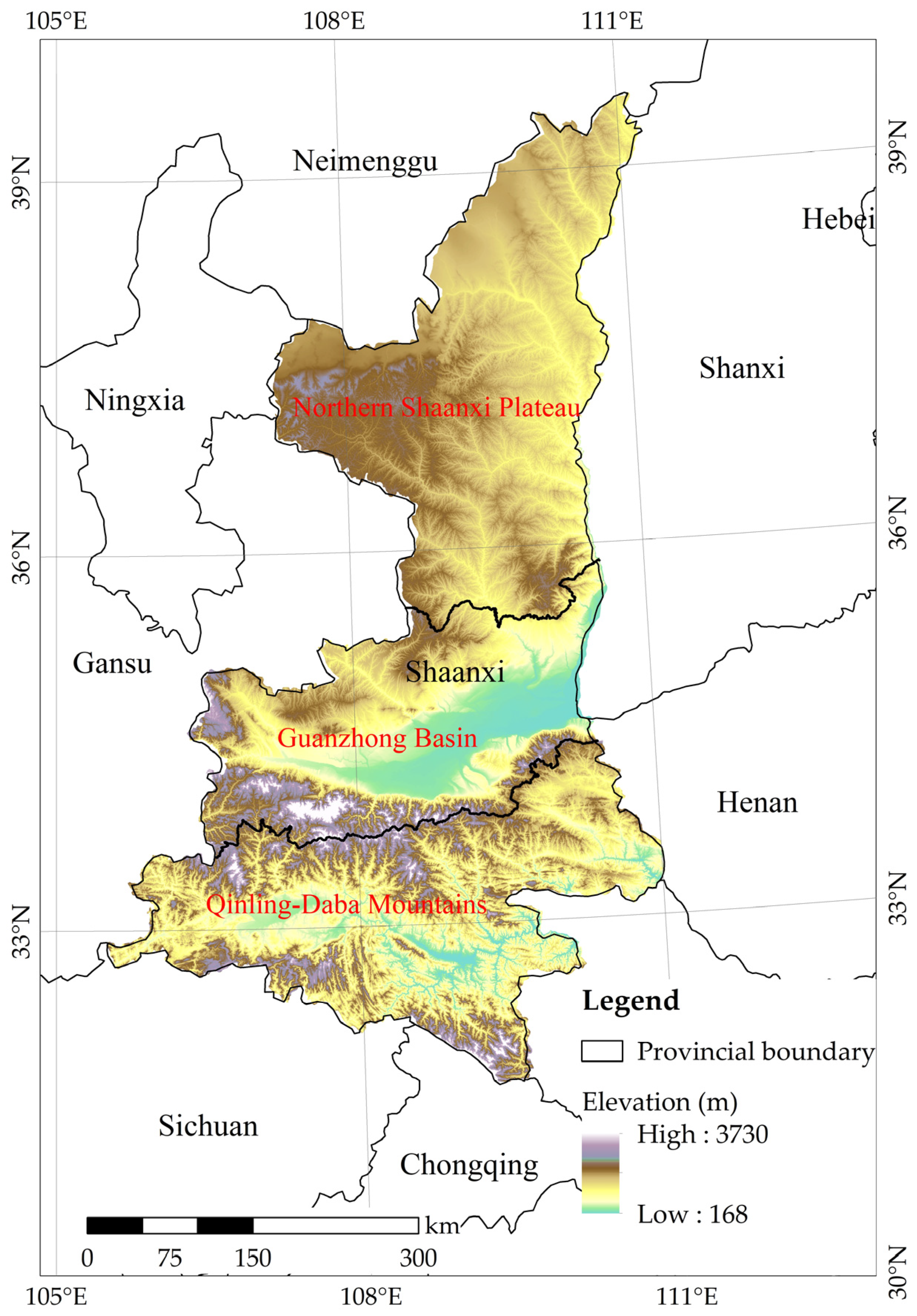
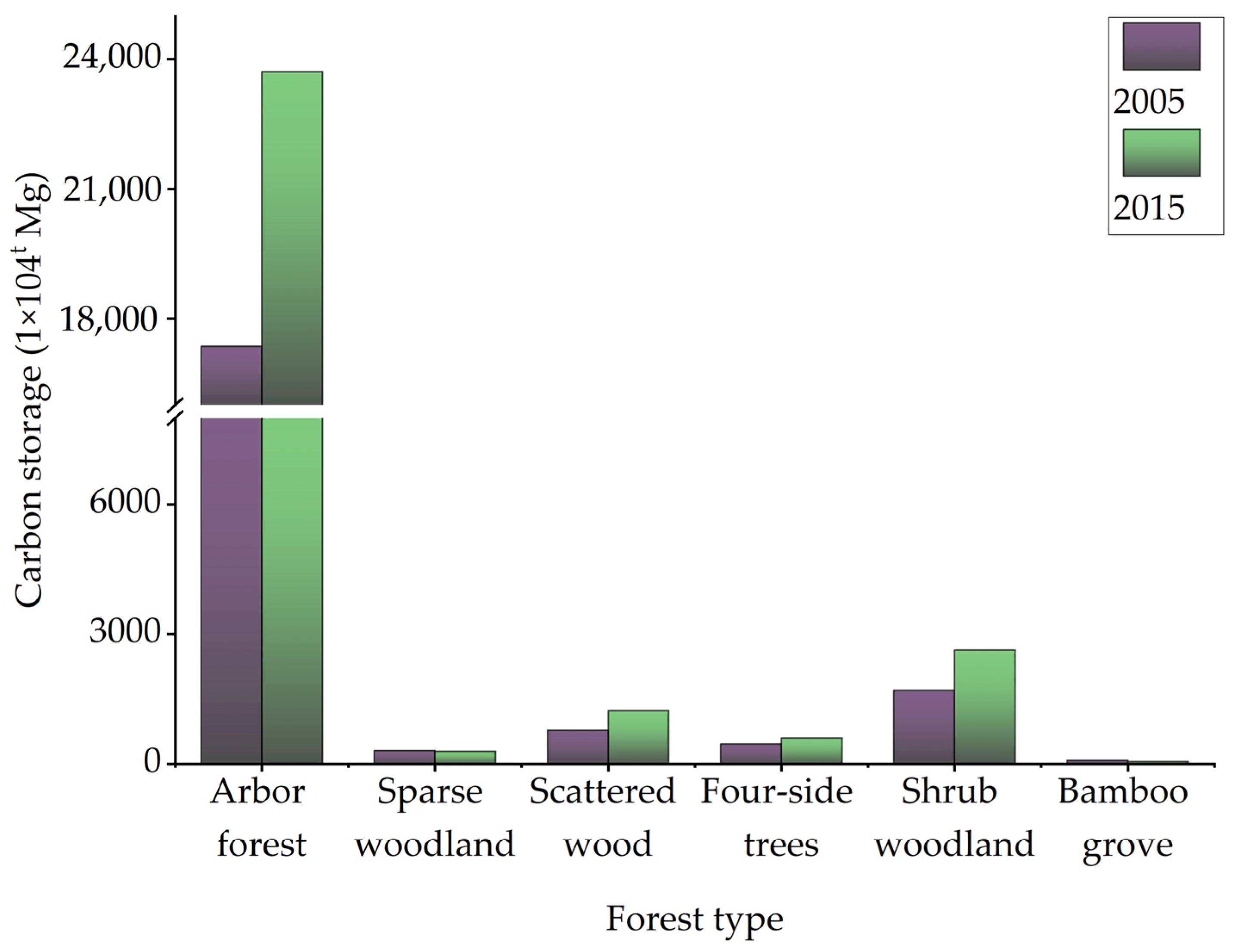
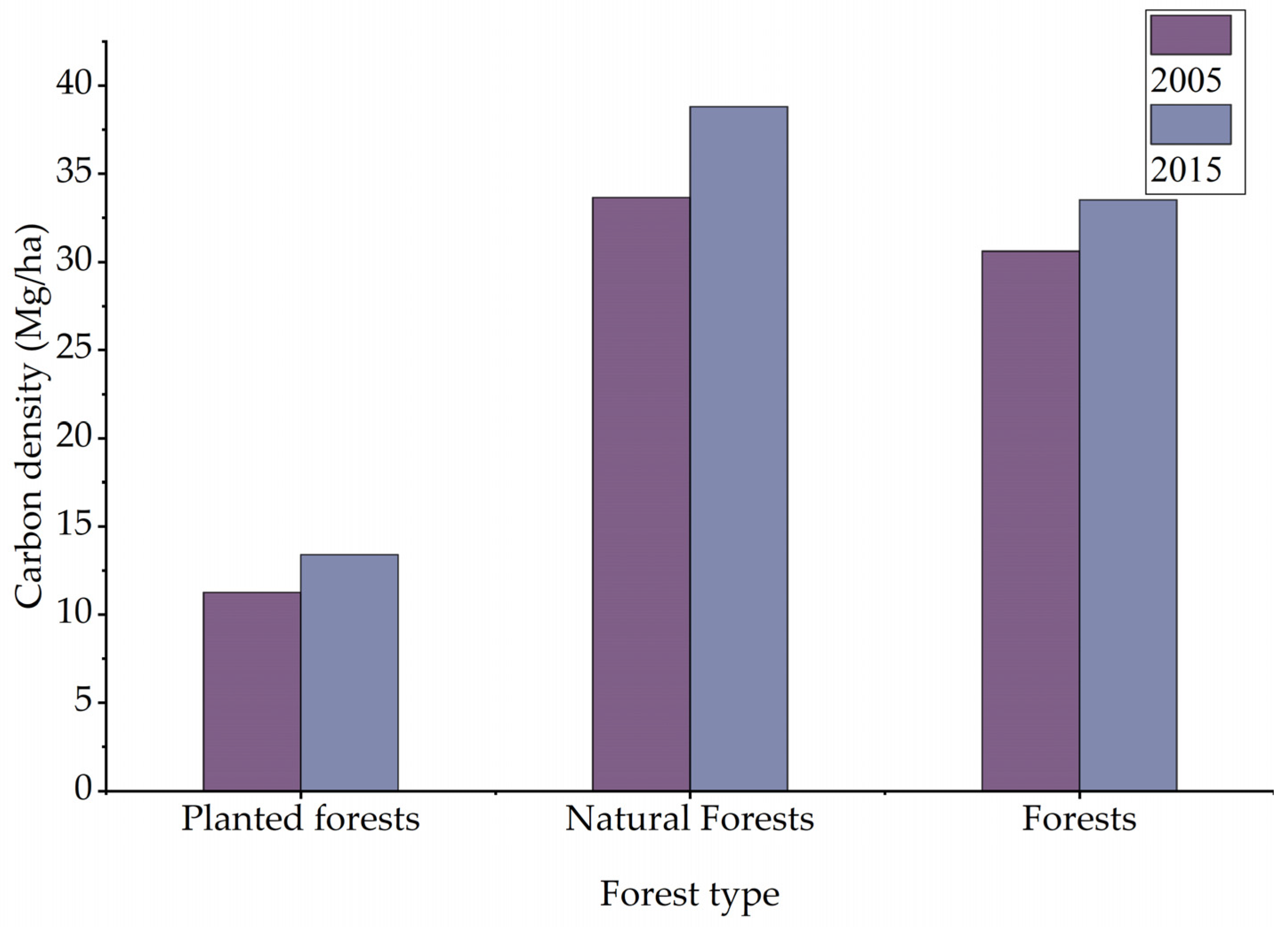
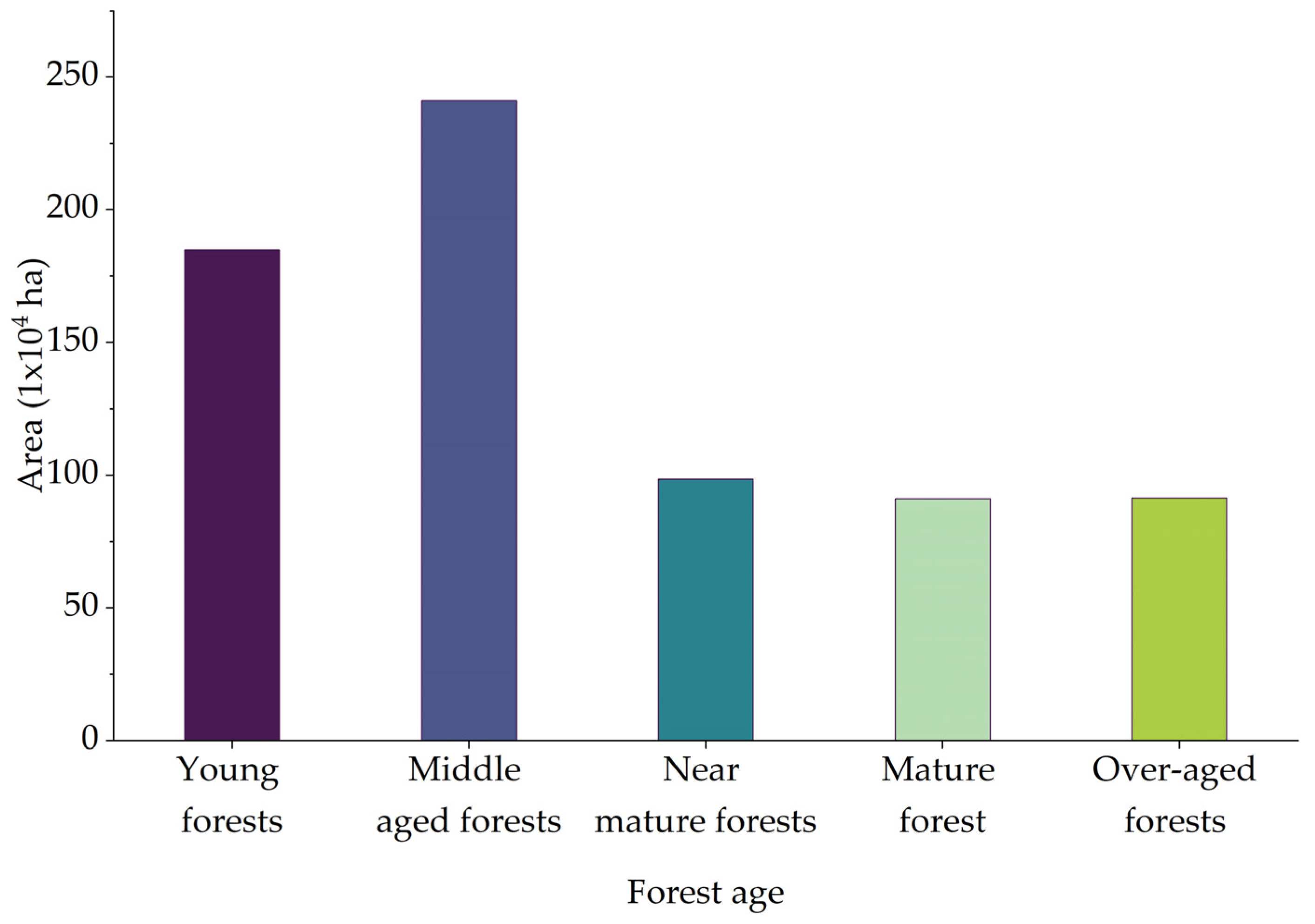
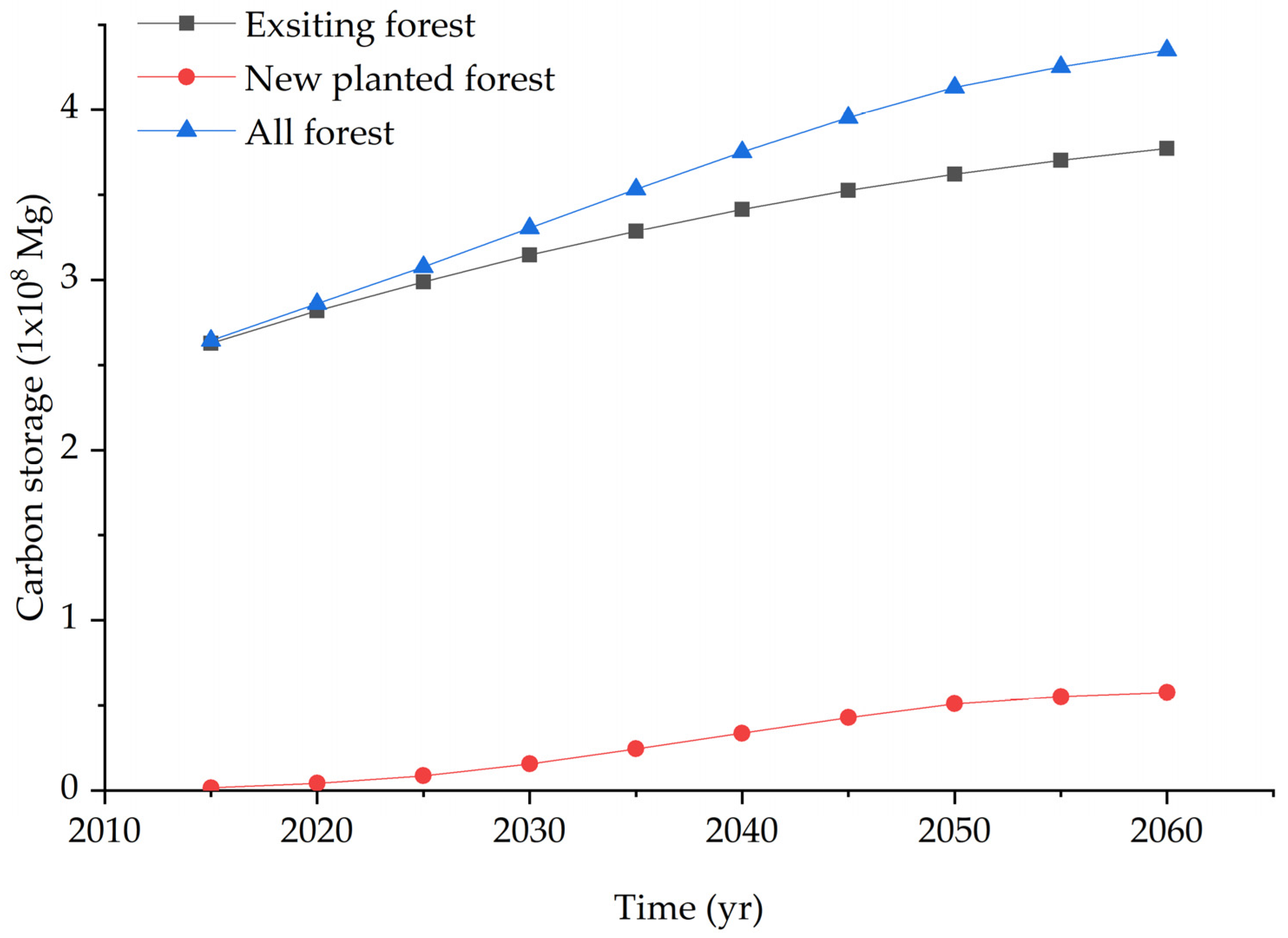
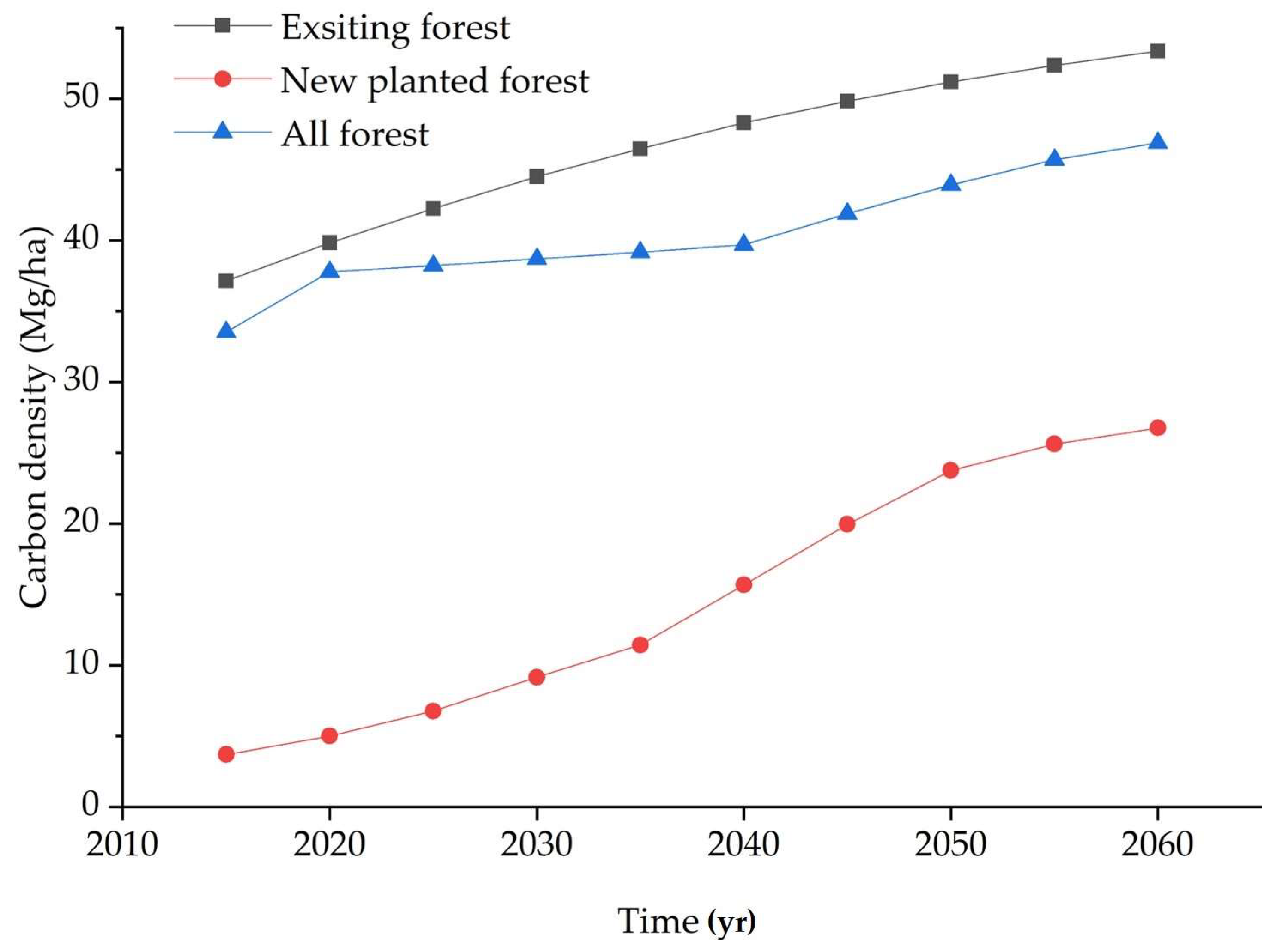
| Age Groups | Forests | Plantations | Natural Forests | |||
|---|---|---|---|---|---|---|
| Carbon Stocks (1 × 104 Mg) | Carbon Density (Mg/ha) | Carbon Stocks (1 × 104 Mg) | Carbon Density (Mg/ha) | Carbon Stocks (1 × 104 Mg) | Carbon Density (Mg/ha) | |
| Total | 23,708.75 | 33.53 | 1967.33 | 13.40 | 21,741.42 | 38.80 |
| Young forest | 2136.93 | 11.56 | 405.58 | 6.93 | 1731.35 | 13.71 |
| Middle-aged forest | 6640.66 | 27.55 | 1121.69 | 16.55 | 5518.98 | 31.84 |
| Near-mature forest | 4685.84 | 47.56 | 177.26 | 24.08 | 4508.58 | 49.45 |
| Mature forest | 4841.79 | 53.10 | 98.13 | 18.04 | 4743.66 | 55.33 |
| Over-aged forest | 5403.53 | 59.08 | 164.67 | 21.44 | 5238.85 | 62.53 |
| Species (Group) | Total | Young Forest | Middle-Aged Forest | Near-Mature Forest | Mature Forest | Over-Aged Forest | ||||||
|---|---|---|---|---|---|---|---|---|---|---|---|---|
| Carbon Stocks | Carbon Density | Carbon Stocks | Carbon Density | Carbon Stocks | Carbon Density | Carbon Stocks | Carbon Density | Carbon Stocks | Carbon Density | Carbon Stocks | Carbon Density | |
| Total | 21,741.42 | 38.80 | 1731.35 | 13.71 | 5518.98 | 31.84 | 4508.58 | 49.45 | 4743.66 | 55.33 | 5238.85 | 62.53 |
| Quercus spp. | 7992.88 | 48.24 | 687.10 | 14.51 | 1376.23 | 40.19 | 1547.17 | 67.18 | 1598.46 | 65.73 | 2783.92 | 75.71 |
| Mixed broad leaf | 7895.58 | 35.27 | 594.87 | 12.66 | 2445.37 | 31.73 | 1915.75 | 43.40 | 1913.21 | 53.88 | 1026.37 | 50.91 |
| Mixed coniferous and broad leaf | 1612.73 | 34.80 | 127.92 | 14.29 | 563.77 | 28.47 | 428.13 | 51.46 | 323.01 | 53.21 | 169.91 | 53.10 |
| Other hard broad leaf | 1442.80 | 37.32 | 132.33 | 16.56 | 411.89 | 33.08 | 106.11 | 30.14 | 393.18 | 64.67 | 399.29 | 46.32 |
| Pinus tabulaeformis | 712.96 | 30.55 | 28.04 | 7.97 | 218.08 | 20.08 | 120.12 | 41.71 | 180.97 | 47.13 | 165.75 | 74.00 |
| Betula spp. | 471.92 | 52.67 | 6.37 | 19.90 | 44.23 | 34.56 | 67.11 | 69.91 | 66.12 | 29.52 | 288.09 | 69.25 |
| Other soft broad leaf | 342.50 | 26.76 | 35.52 | 10.09 | 59.83 | 26.71 | 106.67 | 30.30 | 38.03 | 29.71 | 102.46 | 45.74 |
| Poplar and Willow | 274.50 | 34.36 | 19.87 | 12.42 | 16.30 | 16.98 | 75.68 | 47.30 | 48.41 | 50.43 | 114.23 | 39.80 |
| Pinus massoniana | 205.60 | 23.80 | 42.11 | 21.93 | 163.49 | 24.33 | ||||||
| Abies spp. | 200.34 | 56.92 | 76.32 | 39.75 | 124.02 | 77.51 | ||||||
| Pinus levis | 184.25 | 41.13 | 8.59 | 26.84 | 86.86 | 38.78 | 29.38 | 30.61 | 59.42 | 61.89 | ||
| Cupressus funebris | 137.09 | 18.63 | 29.73 | 15.48 | 41.18 | 18.38 | 22.41 | 23.35 | 34.70 | 18.07 | 9.07 | 28.36 |
| Tsuga chinensis | 85.25 | 88.80 | 68.90 | 107.65 | 16.35 | 51.10 | ||||||
| Tilia tuan | 51.33 | 40.10 | 30.59 | 47.79 | 15.81 | 49.40 | 4.94 | 15.43 | ||||
| Cunninghamia lanceolata | 43.70 | 22.76 | 10.93 | 11.39 | 7.60 | 23.74 | 25.17 | 39.33 | ||||
| Mixed coniferous | 41.82 | 18.67 | 4.75 | 7.43 | 30.18 | 23.57 | 6.89 | 21.54 | ||||
| Ulmus pumila | 34.62 | 21.64 | 3.22 | 10.06 | 23.38 | 24.35 | 8.02 | 25.06 | ||||
| Other pine species | 11.54 | 18.03 | 5.33 | 16.67 | 6.21 | 19.40 | ||||||
| Species (Group) | Total | Young Forest | Middle-Aged Forest | Near-Mature Forest | Mature Forest | Over-Aged Forest | ||||||
|---|---|---|---|---|---|---|---|---|---|---|---|---|
| Carbon Stocks | Carbon Density | Carbon Stocks | Carbon Density | Carbon Stocks | Carbon Density | Carbon Stocks | Carbon Density | Carbon Stocks | Carbon Density | Carbon Stocks | Carbon Density | |
| Total | 1967.33 | 13.4 | 405.58 | 6.93 | 1121.69 | 16.55 | 177.26 | 24.08 | 98.13 | 18.04 | 164.67 | 21.44 |
| Robinia pseudoacacia | 525.85 | 11.11 | 138.5 | 8.49 | 193.56 | 9.04 | 58.2 | 22.74 | 70.63 | 16.98 | 64.96 | 22.56 |
| Pinus tabulaeformis | 377.32 | 17.87 | 31.25 | 4.65 | 294.96 | 22.48 | 51.12 | 39.94 | ||||
| Mixed coniferous and broad leaf | 252.76 | 21.37 | 74.83 | 14.64 | 171.58 | 26.81 | 6.35 | 19.86 | ||||
| Poplar and Willow | 173.76 | 15.54 | 8.53 | 3.83 | 46.03 | 16.04 | 13.11 | 13.66 | 11.25 | 17.58 | 94.84 | 21.17 |
| Pinus massoniana | 127.85 | 25.02 | 27.31 | 42.68 | 85 | 22.19 | 15.53 | 24.27 | ||||
| Mixed broad leaf | 116.44 | 9.34 | 34.82 | 4.19 | 56.9 | 17.78 | 24.72 | 25.75 | ||||
| Mixed coniferous | 91.08 | 19.02 | 0.64 | 2 | 90.44 | 20.23 | ||||||
| Pinus levis | 74.42 | 29.07 | 4.49 | 14.04 | 69.92 | 31.22 | ||||||
| Cunninghamia lanceolata | 68.49 | 16.46 | 27.51 | 14.33 | 36.1 | 18.8 | 4.87 | 15.23 | ||||
| Other hard broad leaf | 46.42 | 5.8 | 10.24 | 2.29 | 18.56 | 6.45 | 5.58 | 17.43 | 12.04 | 37.62 | ||
| Castanea mollissima | 41.55 | 6.18 | 31.22 | 6.97 | 10.33 | 4.61 | ||||||
| Larix spp. | 16.64 | 26 | 1.6 | 4.99 | 15.04 | 47.01 | ||||||
| Quercus spp. | 12.1 | 4.2 | 9.05 | 4.72 | 3.05 | 3.17 | ||||||
| Ulmus pumila | 11.17 | 17.46 | 6.96 | 21.75 | 4.22 | 13.17 | ||||||
| Cupressus funebris | 9.42 | 1.96 | 4.36 | 1.05 | 2.42 | 7.58 | 2.64 | 8.24 | ||||
| Picea spp. | 8.65 | 13.51 | 8.65 | 27.02 | ||||||||
| Abies spp. | 8.6 | 26.89 | 8.6 | 26.89 | ||||||||
| Other soft broad leaf | 4.06 | 3.17 | 0.48 | 0.76 | 3.58 | 5.59 | ||||||
| Pinus sylvestris | 0.74 | 2.31 | 0.74 | 2.31 | ||||||||
Disclaimer/Publisher’s Note: The statements, opinions and data contained in all publications are solely those of the individual author(s) and contributor(s) and not of MDPI and/or the editor(s). MDPI and/or the editor(s) disclaim responsibility for any injury to people or property resulting from any ideas, methods, instructions or products referred to in the content. |
© 2023 by the authors. Licensee MDPI, Basel, Switzerland. This article is an open access article distributed under the terms and conditions of the Creative Commons Attribution (CC BY) license (https://creativecommons.org/licenses/by/4.0/).
Share and Cite
Li, Q.; Xia, X.; Kou, X.; Niu, L.; Wan, F.; Zhu, J.; Xiao, W. Forest Carbon Storage and Carbon Sequestration Potential in Shaanxi Province, China. Forests 2023, 14, 2021. https://doi.org/10.3390/f14102021
Li Q, Xia X, Kou X, Niu L, Wan F, Zhu J, Xiao W. Forest Carbon Storage and Carbon Sequestration Potential in Shaanxi Province, China. Forests. 2023; 14(10):2021. https://doi.org/10.3390/f14102021
Chicago/Turabian StyleLi, Qi, Xianli Xia, Xiaomei Kou, Le Niu, Fan Wan, Jianhua Zhu, and Wenfa Xiao. 2023. "Forest Carbon Storage and Carbon Sequestration Potential in Shaanxi Province, China" Forests 14, no. 10: 2021. https://doi.org/10.3390/f14102021
APA StyleLi, Q., Xia, X., Kou, X., Niu, L., Wan, F., Zhu, J., & Xiao, W. (2023). Forest Carbon Storage and Carbon Sequestration Potential in Shaanxi Province, China. Forests, 14(10), 2021. https://doi.org/10.3390/f14102021






